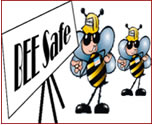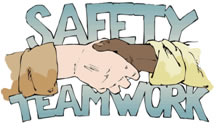Skip to Content | CAO Homepage
Alameda County Law Library Building
125 - 12th Street, 3rd Floor, Oakland, CA 94607 · 510-272-6920

Safety Committees
Alameda County requires each Agency or Department to have an active safety committee consisting of management and non-management employees. The purpose of a safety committee is to bring workers and managers together to achieve and maintain a safe, healthful workplace. It's easy to start a safety committee, but to develop an effective one - one that achieves and maintains a safe, healthful workplace - requires employees and managers committed to achieving that goal.
According to OSHA, the most effective safety committees work together to find solutions to problems that cause workplace accidents, illnesses, and injuries. Fewer accidents, injuries, and illnesses mean lower workers' compensation claims costs. Successful agency/departments have safe, healthful workplaces.
Safety Committee Benefits
Safety committees can play a key role in the safety structure of an agency/department. An active and effective safety committee whose membership and functions reflect the agency/departmentís size, complexity, and operating exposures can significantly improve safety. This is accomplished by instituting programs and providing support that helps to reduce accidents, injuries, and illnesses within the agency/department.
The benefits of a safety committee are numerous. Some of the most common benefits include the fact that a safety committee can:

Group decisions have the advantage of the group's wider field of experience.
- Provide a forum for problem solving that can withstand changes in management and personnel assignments without losing overall focus and direction.
- Provide supervisors and managers with a resource to turn to when they are faced with safety problems that they might not have the time or technical expertise to deal with effectively.
- Involve more people in the overall safety and health management of the agency/department.
- Mobilize and get people working together who may not have had previous business reasons to work together, thereby helping to open up healthy lines of communication that may not have existed before.
- Provide people with a broader base of safety knowledge through rotation of assignments as subcommittee chairpersons to other subcommittees and as subcommittee members. This helps build the safety culture in the County.
The safety committee is the group that designs and implements programs, solves problems, and acts as a monitoring body for safety. The committee acts as a consultant to senior management by identifying problems and recommending solutions.
In many organizations, the safety committee is the energetic group that acts as the spark to activate interest and participation in the safety program from all levels of management and front line employees. Through the safety committee activities, the message is communicated that indeed, the employees are the most valuable resource the County has. As such, management is interested in protecting that most valuable asset.
Essential Activities

Anyone can start a safety committee, but, to make it effective, the committee must be built on a foundation of management commitment and must be accountable for achieving its goals. The committee must:
- Involve employees in achieving the committee's goals.
- Identify workplace hazards.
- Review reports of accidents and near misses.
- Keep accurate records of committee activities.
- Evaluate its strengths and weaknesses.
Commitment
The committee won't survive without management support. Management demonstrates support by encouraging employees to get involved in achieving a safe, healthful workplace and by acting on the committee's recommendations.
Representatives demonstrate commitment by attending committee meetings, following through on their assigned tasks, and encouraging other employees to get involved in identifying hazards.
Accountability
Representatives should understand that the committee expects them to contribute; each representative shares responsibility for accomplishing safety committee goals, which benefit everyone in the organization.
The safety committee is also responsible for monitoring how management holds employees accountable for working safely and for recommending ways to strengthen accountability.
Employee Involvement
To become effective, a safety committee needs help from everyone in your agency/department. The safety committee must have a method for employees to report hazards and offer safety suggestions. Ways the safety committee can encourage employees to get involved:
- Encourage employees to report hazards and unsafe work practices to a safety committee representative.
- Act on employee suggestions and recognize their contributions to a safer workplace.
- Promote the committee's activities and accomplishments.
- Make sure employees know that you have or are starting a safety committee. Describe its role in the agency/departmentís safety and health program, and explain management's commitment to the committee.
Inform employees in a memo or a newsletter, by email, or - better yet - meet with them to promote the committee and answer questions.
Hazard Identification
The safety committee plays an important role in keeping the workplace hazard-free:
- Ensure that representatives know how to recognize hazards and understand basic principles for controlling them.
- Focus on identifying hazards and unsafe work practices that are likely to cause serious injuries.
- Conduct thorough workplace inspections at least annually.
- Document hazards during annual inspections and discuss how to control them at regular safety committee meetings.
- Include employer and employee representatives on the inspection team.

Accident Investigation
The committee must have a procedure for investigating all workplace accidents, illness, and deaths. It's not necessary for the committee to conduct accident investigations or to participate in investigations; however, the committee should ensure that management does so. The committee should also carefully review accident reports to help management identify accident causes and determine how to control them.
Recordkeeping
You may not think of recordkeeping as an essential activity, but accurate, well-organized records document the committee's accomplishments and can inform the committee what it needs to do to improve. The following documents should be in the safety committee's file:
- Accurate minutes of each safety committee meeting
- Committee reports, evaluations, and recommendations
- Management's response to committee recommendations
- Employee safety suggestions and hazard concerns
Evaluation
Evaluation answers the question "Are we effective?" Effective safety committees periodically evaluate their strengths and weaknesses, and the evaluation helps them set new goals.
At least once a year, schedule a half-day safety committee meeting to accomplish the following:
- Identify the achievements over the past 12 months
- Review essential activities
- Set goals for the next 12 months
Safety Committee Pitfalls
Although safety committees are usually positive forces for safety in an agency/department, they are still subject to setbacks and obstacles that can hamper their work. With the responsibilities of the committee come the same types of problems that plague many organizational efforts. Some of the common pitfalls that affect safety committees include:

- Unclear or poorly defined safety committee goals.
- Lack of a clearly stated mission for the safety committee.
- Forgetting the mission of the safety committee.
- Believing that the mission is cast in stone.
- Failure to communicate the mission of the safety committee to managers, supervisors and employees.
- Inattentiveness to employee feedback.
- Becoming overwhelmed by the number of problems uncovered by the committee.
- Getting sidetracked by complainers.
- Failure to provide adequate training and guidance to the safety committee to allow them to complete their work.
- Management sending double messages about safety rules.
- Reacting to the problems rather than working to improve the system that creates the problems.
- Lack of an atmosphere conducive to employee safety.
- Failure to follow through on recommended corrections or employee suggestions.
- Expectation of immediate results.
- Basing safety decision-making solely on costs.
- Gathering data for judgmental rather than informational purposes.
- Failure to establish a long-range plan for improving the safety process.
Source material was provided by J. J. Keller & Associates

